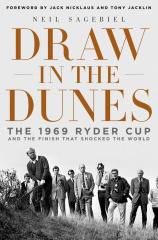Draw in the Dunes: The 1969 Ryder Cup and the Finish That Shocked the World
Review
Draw in the Dunes: The 1969 Ryder Cup and the Finish That Shocked the World
1927 was an extraordinary year in history. Charles Lindbergh flew non-stop across the Atlantic, Babe Ruth hit 60 home runs for the New York Yankees, and Henry Ford introduced his newest car design for a nation falling in love with the automobile. With all of this excitement, a quiet golf match between England and the United States could not be expected to draw much attention.
The first Ryder Cup matches were played in June 1927 at the Worcester Country Club in Worcester, Massachusetts. The United States cruised to an easy victory. For decades, the Americans dominated the biennial contest between the U.S. and a team of golfers from Great Britain and Ireland, and in 1979 Europeans were added to the competition as part of the opposing team. The Ryder Cup matches soared in popularity as the Europeans became more competitive, and national spirit ignited media attention.
"Methodically, but with wonderful attention to detail, Sagebiel recounts each day’s morning and afternoon session of matches.... DRAW IN THE DUNES captures the 1969 Ryder Cup in vivid detail and is a stirring addition to a growing history of this event."
Next week, the two teams do battle in Gleneagles, Scotland. It culminates after a year of hype and hoopla. But it was not always so. Neil Sagebeil’s DRAW IN THE DUNES chronicles a Ryder Cup matched played under quieter circumstances but was made famous by an act of sportsmanship that has become an enduring part of Ryder Cup history. The competition is a multi-day series of matches between a team of golfers from Europe and America. Each match counts for one point and is played as an individual event. Part of the romance of the event is that it is not played as a typical golf tournament where the lowest score over four rounds leads to one golfer claiming victory. Each match in the Ryder Cup has its own drama.
In the 1969 battle, the teams came down to the final hole in the final match between probably the two best golfers in the world. On that last hole with the match all even, Jack Nicklaus conceded a putt of slightly more than two feet in length, allowing Englishman Tony Jacklin to tie the match, ending the competition as a tie. The U.S. retained the Ryder Cup, but the English team, huge underdogs entering the match, gained the satisfaction of nearly defeating their American counterparts.
DRAW IN THE DUNES is Sagebeil’s second book of golf history. In 2012 he wrote THE LONGEST SHOT, the story of Jack Fleck’s incredible upset of Ben Hogan at the 1955 U.S. Open. His account of the Ryder Cup is enriched by the availability of most of the golfers and participants, and he also interviewed several of the journalists who covered the event. Nicklaus and Jacklin, who remain friends to this day, contributed introductions to an exhilarating sports history that brings this memorable sports contest to life.
The 1969 matches occurred against a backdrop of regular victories by the United States team. They had won 14 of the 17 matches, and the frenzy that is now associated with the Ryder Cup matches was simply absent from that battle. The U.S. team, captained by Sam Snead, had 10 of its 12 members playing in their first Ryder Cup. Even Nicklaus, who by 1969 had won seven major championships, was a rookie. The antiquated rules of the PGA, which selected the team, had prevented the world’s best golfer from participating in the Ryder Cup until he had played professionally for five years.
Methodically, but with wonderful attention to detail, Sagebiel recounts each day’s morning and afternoon session of matches. The participants add their recollections and seem not to have lost their appreciation for the tone of the contest. Unprepared for the challenge that the British team would mount, the U.S. was lackadaisical at the outset, but the English were determined to make it a match. As the Americans realized they were in for a battle, tempers flared. At one point, American Ken Still berated members of the gallery for their rude behavior.
Ultimately, though, the gentlemanly nature of golf prevailed. Nicklaus’s gesture on the final hole, while controversial, has become one of the iconic moments in sports. Nicklaus and Jacklin even co-designed a golf course that they aptly named The Concession. DRAW IN THE DUNES captures the 1969 Ryder Cup in vivid detail and is a stirring addition to a growing history of this event.
Reviewed by Stuart Shiffman on September 19, 2014
Draw in the Dunes: The 1969 Ryder Cup and the Finish That Shocked the World
- Publication Date: September 9, 2014
- Genres: History, Nonfiction, Sports
- Hardcover: 320 pages
- Publisher: Thomas Dunne Books
- ISBN-10: 1250015952
- ISBN-13: 9781250015952





